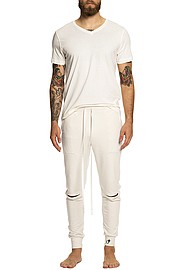Domestic Production Is Central to the TateJones Mission
Manufacturing
As of Thursday, September 12, 2019
In September 2018, high school friends Shawn Harrison and Stacey Horton launched TateJones, a female-founded, Los Angeles–based luxury-basics brand made in the City of the Angels.
For Harrison, who formerly owned a photo-production company, she found Horton, a former interior designer, to be the perfect partner as the two thrive on pursuing creative projects and share a passion for quality apparel.
“We started with a vision of creating garments that could be truly lived in from day to night or night to day depending on your lifestyle,” Harrison said. “We wanted something that could go between home, bedroom and office or following kids, hanging out with friends and traveling.”
Designing for themselves and, eventually, their families, Harrison and Horton created a collection of sweatshirts, oversized and more-fitted T-shirts, sweatpants and lounge shorts that include streetwear-style details and luxurious fabrics. Their color palette relies only on black and pepper white, a creamy hue. Each of the pieces could be worn either during a lazy day at home or paired with accessories and more-tailored garments to create looks perfect for the office or a night out.
With four children, three of whom are Millennial adults, Horton found inspiration through observing how the older children dressed, eventually incorporating design elements that reflected the stylish yet easy dressing she saw.
“My three adult children are all very on-trend, but I noticed the way they were expressing their creativity and fashion. It was this circulation of clothes on repeat. In reality, they were going to bed in what they wore during the day and basically doing the same thing over and over again,” Horton said. “When Shawn and I started talking about this, it resonated with me right away.”
Using a small-batch approach to manufacturing, the women of TateJones release a few pieces gradually throughout the year. With partners including Asher Fabric Concepts, Epic Textiles and Pacific Knits, they are proud to not only be made in Los Angeles but also sourcing their cotton, Modal and Supima fabrics in the United States.
“We knew right away that we wanted to be in L.A. and produce in L.A. We respect and appreciate the city. We knew we would find everything we needed in L.A.,” Horton said. “It was important for our company ethos to court local businesses. We want to give back to the local economy. It’s helped us serve the interests of our customers. It’s helpful to the health of the entire domestic process.”
One element of the brand’s manufacturing is sourced from outside the United States. Using Shindo stretch twill from Japan, TateJones features this material to highlight details that are usually overlooked on apparel.
“That grosgrain is on our drawstring bottoms, it details many of our sweatshirts and borders all of our pockets for that little special luxury,” Horton said.
As a brand that relies on domestic manufacturing, TateJones is also committed to a more-sustainable approach throughout its entire supply chain. Harrison and Horton note that by manufacturing apparel in Los Angeles they are reducing TateJones’s carbon footprint, but they also wanted to do more by relying on boxes, tissue and tape that are eco-friendlier than traditional options.
As one of the most notoriously pollutive components of packaging, sourcing sustainable poly bags posed a challenge, but Harrison and Horton remained committed to finding an eco-friendlier option and discovered a product that is produced in the United States from 100 percent recycled content and is recyclable at locations where #4 flexible plastic is processed.
“Making the commitment to not source from China is difficult—down to every little thing such as our tissue paper. The research and the time it takes to keep everything in the U.S. and sustainable is extremely enlightening,” Harrison said. “The packaging is an integral part of our business. We wanted to do it sustainably.”
Relying on a direct-to-consumer approach for selling their pieces, Harrison and Horton are not connecting with retail partners—yet. It is important to their mission to establish the brand’s reputation with their customers before opening up their collection to other businesses.
“We wanted to build a brand at a pace that works well for us,” Harrison said. “It is strong and it has its own character. We wanted the brand to become the brand before we started going into a lot of different directions.”
The tactic has proven successful as the women have noticed return customers buying their pieces as the brand continues to drop new product. As the year closes in on the fourth quarter, TateJones will release three new styles in time for the holidays but will also continue to sell its pieces from previous seasons. At least two new styles will be released in the spring.
“Given time, maybe those things will shift a bit, but a big mandate is to keep those core pieces there,” Horton said. “We are super honored. Our clients now are into their third buying trend and they keep coming back. We want to keep those original pieces in our line.”
Available online at tatejones.us, the brand offers men’s styles in S–XL and women’s pieces in sizes XXS–L priced at $65–$240.


